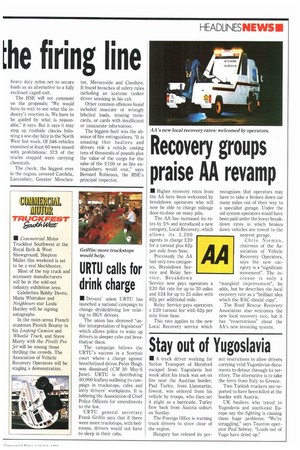Hazchem flatbeds in the firing line
Page 6

Page 7

If you've noticed an error in this article please click here to report it so we can fix it.
• A local authority body is calling for flatbeds to be banned from transporting hazardous substances to avoid accidents like the acid spillage on the MI which left 15 people in hospital (CM 1-7 November 1990).
Only fully enclosed trailers with side and top walls should be used for carrying dangerous liquids, says the Association of County Councils' emergency planning committee.
It plans to meet the Health and Safety Commission this month to discuss the proposals, which might even affect curtainsiders.
"We have hard evidence that when flatbeds are involved in accidents their loads can too easily fall off. After the accident on the MI, when a 300-mile stretch of the southbound carriageway had to be resurfaced, it showed us something had to be done," says the ACC's Clive Grenyer.
He cites Bedfordshire County Council's investigation into last October's accident, which concluded that if the operator, OB Transport, had used an enclosed vehicle, the likelihood of a spillage would have been greatly reduced.
OB Transport was fined £1,000 for using an unsuitable vehicle for the load and road conditions on the day of the accident. It was fined a further £1,000 for failing to secure the load properly.
Dave Hunter recently set up a hazchem training firm after a career in the police specialising in hazardous goods transport. He believes that if loads are properly secured there is no reason why flatbeds should not be used, but he recommends that flatbed operators should consider fitting tail and side boards.
Bob Pearson, hazardous goods consultant to transport law firm Ward and Associates, seconds that view. He would like to see more operators using flatbeds with side and tail boards, but thinks the ACC's proposals go too far. He suggests using a heavy duty nylon net to secure loads as an alternative to a fully enclosed caged unit.
The HSE will not comment on the proposals: "We would have to wait to see what the industry's reaction is. We have to be guided by what is reasonable," it says. But it says it may step up roadside checks following a one-day blitz in the North West last week. Of 546 vehicles examined at least 60 were issued with prohibitions: 373 of the trucks stopped were carrying chemicals, The check, the biggest ever in the region, covered Cumbria, Lancashire, Greater Manches ter, Merseyside and Cheshire. It found breaches of safety rules including an acetone tanker driver smoking in his cab.
Other common offences found included insecure or wrongly labelled loads, missing tremcards, or cards with insufficient or innacurate information.
The biggest fault was the absence of fire extinguishers. "It is amazing that hauliers and drivers risk a vehicle costing tens of thousands of pounds plus the value of the cargo for the sake of the £100 or so fire extinguishers would cost," says Bernard Robinson, the HSE's principal inspector.
















































































